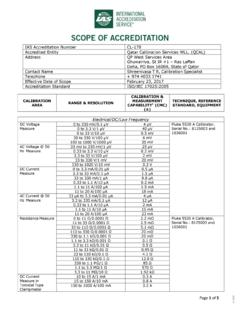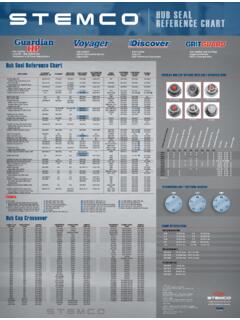Transcription of The new ISO/IEC 17025:2017 - IAS: The International ...
1 The new ISO/IEC 17025:2017 1 | Page The new ISO/IEC 17025:2017 By Dr. George Anastasopoulos Director, Conformity assessment, IAS Email: Introduction - Background information ISO/IEC 17025 was first issued in 1999 by the International Organization for Standardization (ISO) and the International Electro-technical Commission (IEC). It is the single most important standard for calibration and testing laboratories around the world, with more than laboratories accredited, globally. At the International Laboratory Accreditation Cooperation (ILAC) General Assembly in October 2013 the Laboratory Committee (which is composed of stakeholder representatives of accredited testing and calibration) recommended that ILAC request that ISO/CASCO establish a new work item to comprehensively revise ISO/IEC 17025 :2005.
2 CASCO is the ISO committee that works on issues relating to conformity assessment. CASCO develops policy and publishes standards related to conformity assessment; it does not perform conformity assessment activities. CASCO's standards development activities are carried out by working groups made up of experts put forward by the ISO member bodies. The experts are individuals who possess specific knowledge relating to the activities to be undertaken by the working group. The 6th ISO/CASCO WG 44 meeting was held on July 10-12, 2017 in ISO Central Secretariat, Geneva. The deliverable of this meeting was the FDIS version of the new ISO/IEC 17025 version. The document is expected to proceed to publication, planned for end November/December 2017 .
3 Please note that throughout this article the term the standard refers to the new ISO/IEC 17025:2017 . About the New Standard The format of the new standard has been significantly changed to be more in line with new ISO formatting guidelines. The basic format is similar to other new standards such as ISO/IEC 17020 and ISO/IEC 17065. The new standard is now structured as follows: 1. Scope 2. Normative references 3. Terms and definitions 4. General requirements 5. Structural requirements The new ISO/IEC 17025:2017 2 | Page 6. Resource requirements 7. Process requirements 8. Management requirements Annex A Metrological Traceability (Informative) Annex B Management System (Informative) Bibliography General Information According to International Accreditation Forum (IAF) and the International Laboratory Accreditation Cooperation (ILAC), accreditation is defined as the independent evaluation of conformity assessment bodies against recognized standards to ensure their impartiality and competence.
4 This standard was developed with the objective of promoting confidence in the operation of laboratories and contains requirements for laboratories to enable them to demonstrate that they operate in a competent and impartial way and that they are able to provide valid results. During its development phase it has been tried to align the standard with the principles of ISO 9001, although this was not always practically possible. Still it is a fair statement to make that the laboratories complying with the standard will also, in general, comply with the principles of ISO 9001. The standard can be used for accreditation purposes, for self-assessment of the laboratories and for second party assessments by laboratory customers, regulatory authorities, organizations and schemes using peer-assessment.
5 Its requirements are applicable to any organization that performs the activities of testing and/or calibration and/or sampling associated with subsequent testing or calibration. Therefore, accreditation to the new standard can be also achieved by organizations offering sampling associated with subsequent testing or calibration. When the standard uses the term laboratory is referring to any of the 3 options mentioned above (testing, calibration, and sampling). The potential of performing only sampling activities is a new element in the standard. If, for example, a laboratory is performing tests and takes samples by its own capacity, it should meet all requirements related to both: sampling and testing. On the other hand, if any organization performs only sampling and then the samples are forwarded to a laboratory for testing, then this organization should comply with new standard requirements regarding sampling and its management system should ensure that the sampling activity doesn t affect negatively on test results.
6 Requirements for sampling organizations are similar to testing and calibration laboratories: personnel shall be competent, equipment has to be maintained and calibrated, sampling procedure has to be validated, quality of sampling has to be assured etc. Confirmation of competence of organization to provide sampling can be provided through accreditation against the new ISO/IEC 17025 . Guide 99 ISO/IEC , International vocabulary of metrology basic and general concepts and associated terms (VIM), is referenced in the standard as a normative reference. The definitions also given in ISO/IEC The new ISO/IEC 17025:2017 3 | Page 17000 are applicable. In addition, the standard provides the detailed definitions of the terms impartiality, complaint, interlaboratory comparison, intralaboratory comparison, proficiency testing, laboratory, decision rule.
7 Main Requirements The Standard introduces its main requirements throughout the clauses 4 to 8. Clause 4 - General requirements Impartiality and Confidentiality requirements are discussed in clause 4. The risk-based thinking is evident throughout the standard. It should be noted that the new standard expects from the laboratory to plan and implement actions to address risks and opportunities. Although addressing risks and opportunities is laboratory s responsibility, the standard sets specific requirements. The first requirement of such risks and opportunities that is needed to be addressed is mentioned in clause 4, where the laboratory is required to identify and eliminate or minimize risks related to impartiality, on an on-going basis.
8 The confidentiality requirements include, among others, the responsibility of the laboratory to inform its customer in advance, of the information it intends to place in the public domain. It is also discussing how to handle the release of confidential information required by law or authorized by contractual arrangements. The confidentially requirement is also extended to laboratory personnel, including any committee members, contractors, personnel of external bodies, or individuals acting on the laboratory's behalf, even in the case that information is obtained from sources other than the customer ( complainant, regulators). Clause 5 - Structural requirements In clause 5, main requirements are defined, including: Legal status of the laboratory, organization and management structure, identification of management, range of laboratory activities, documenting its procedures, availability of personnel responsible for the implementation and maintaining the integrity of the management system.
9 It should be noted that the new standard clearly requires (see clause ) that the laboratory shall only claim conformity with this document for this range of laboratory activities, which excludes externally provided laboratory activities on an ongoing basis. This means that the laboratory is expected to be accredited, and include in the scope of accreditation only testing/calibration/sampling activities that is providing by utilizing its own resources. In its 2005 version the standard allowed to subcontract tests and calibrations in the case that the laboratory was not in position to perform them. According to the new standard the laboratory can be accredited only for those laboratory activities, for which it is competent.
10 Subcontracting is allowed only for outstanding situations, like overload of work, sickness of personnel, maintenance of equipment or other similar cases. The new ISO/IEC 17025:2017 4 | Page Clause 6 - Resource requirements Resource requirements are considered to include personnel, facilities, equipment, systems and support services necessary to manage and perform the laboratory activities. It is expected that all internal or external personnel of the laboratory shall be competent and act impartially. The standard doesn t refer at this clause to ALL personnel, but only to personnel who could influence on the results of laboratory activities. This is not only personnel who is directly involved in testing/calibration/sampling activities, but also personnel who is indirectly involved, like technical personnel.






